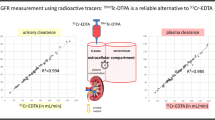Abstract
Critical factors determining the renal handling of 99mTc-dimercaptosuccinic acid (DMSA) are protein binding in plasma and the renal 99mTc-DMSA extraction efficiency. Comparison of the count rate over soft tissue with that over the cardiac blood pool about 1 h after injection demonstrated that 99mTc-DMSA is not exclusively an intravascular label. 99mTc-DMSA was 76% protein bound in plasma as demonstrated by HPLC and gel filtration. Assuming that the 24% that is not protein bound is filtered at the glomerulus, the renal extraction efficiency of 99mTc-DMSA by glomerular filtration is about 5%. Since the total renal extraction efficiency was also found to be about 5%, the majority of the activity that becomes fixed in the renal cortex arrives there as a result of filtration followed by tubular reabsorption rather than by direct extraction from peritubular blood. However, discordant changes in DMSA and DTPA uptake induced by captopril in renovascular hypertension (RVH) suggested that a minority of uptake was by direct peritubular extraction.
This kinetic model was supported by indirect measurement of protein binding and extraction efficiency based on the kinetics of 99mTc-DMSA disappearance from plasma and kinetics of uptake in the kidneys. Furthermore, differential functional studies based on 99mTc-DMSA and 99mTc-DTPA before and after captopril in patients with RVH due to unilateral renal artery stenosis confirmed filtration followed by tubular reabsorption as the predominant route for DMSA uptake by the kidney.
Similar content being viewed by others
References
Arnold RW, Subramanian G, McAfee JG, Blair RJ, Thomas ED (1975) Comparison of 99mTc complexes for renal imaging. J Nucl Med 16:357–367
Blaufox MD (1987) The current status of renal radiopharmaceuticals. A Review. Contrib Nephrol 56:31–37
Bolton AE (1977) Radio-iodinisation techniques. Wembley Middlesex, Printavarium
Chervu IR, Blaufox MD (1982) Renal radiopharmaceuticals — an update. Semin Nucl Med 12:224–245
Fommei E, Ghione S, Palla L, Meijers S (1985) Captopril suppresses glomerular filtration rate but not blood flow in the affected kidney in renovascular hypertension: report and comments on one case. J Nucl Med All Sci 29:175–177
Goldraich NP, Alvarenga AR, Goldraich IH, Ramos OL, Sigulem D (1985) Renal accumulation of 99mTc-DMSA in the artificially perfused isolated rat kidney. J Urol 134:1282–1286
Gordon I, Evans K, Peters AM, Kelly J, Morales BN, Goldraich N, Yau A (1987) The quantitation of 99mTc-DMSA in paediatrics. Nucl Med Commun 8:661–670
Gordon I (1987) Indications for 99m-technetium dimercaptosuccinic acid scan in children. J Urol 137:464–467
Kremer-Hovinga TK, Beukhof JR, Van Luijk WHJ, Piers DA, Donker AJM (1984) Reversible diminished renal 99mTc-DMSA uptake during converting enzyme inhibition in a patient with renal artery stenosis. Eur J Nucl Med 9:144–146
Lin TH, Khentigan A, Winchell HS (1974) A 99mTc chelate substitute for organoradiomercurial renal agents. J Nucl Med 15:34–35
McAfee JG, Subramanian G (1984) Radioactive agents for imaging. In: Freeman LM (ed) Clinical Radionuclide Imaging. Grune and Stratton, Florida, pp 55–179
McAfee JG, Grossman ZD, Gagne G, Zens AL, Subramanian G, Thomas FD, Fernandez P, Roskopf ML (1981) Comparison of renal extraction efficiencies for radioactive agents in the normal dog. J Nucl Med 22:333–338
Moretti JL, Rapin JR, Saccavini JC, Langeron A, Le Poncin M, Bardy A (1984) 2,3-Dimercaptosuccinic acid chelates-2. Renal localisation. Int J Nucl Med Biol 11:275–279
Peters AM, Gunasekera RD, Henderson BL, Brown J, De Souza M, Ash JM, Gilday DL, Lavender JP (1987) Non-invasive measurement of blood flow and extraction fraction. Nucl Med Commun 8:823–837
Piepz A, Dobbeleir A, Erbsmann F (1977) Measurement of separate kidney clearance by means of 99mTc-DTPA complex and a scintillation camera. Eur J Nucl Med 2:173–177
Taylor A Jr, Lallone R (1985) Differential renal function in unilateral injury: possible effects of radiopharmaceutical choice. J Nucl Med 26:77–80
Van Luijk WHJ, Ensing GJ, Meijer S, Donker AJM, Piers DA (1984) Is the relative 99mTc-DMSA clearance a useful marker of proximal tubular dysfunction? Eur J Nucl Med 9:439–442
Van Luijk WHJ, Piers DA, Beekhuis H (1986) Renal handling of technetium 99m-DMSA: Further evidence for glomerular filtration and proximal tubular re-absorption. J Nucl Med 27:1943
Wenting GJ, Derkx FHM, Tan Tjiong LH, van Seyer AJ, Man in't Veld AJ, Schalekamp MADH (1987) Risks of angiotensin converting enzyme inhibition in renal artery stenosis. Kidney International 31 [Suppl] 20:S180-S183
Yee CA, Lee HB, Blaufox MD (1981) 99mTc-DMSA renal uptake; influence of biochemical and physiologic factors. J Nucl Med 22:1054–1058
Author information
Authors and Affiliations
Rights and permissions
About this article
Cite this article
Peters, A.M., Jones, D.H., Evans, K. et al. Two routes for 99mTc-DMSA uptake into the renal cortical tubular cell. Eur J Nucl Med 14, 555–561 (1988). https://doi.org/10.1007/BF00286776
Received:
Accepted:
Issue Date:
DOI: https://doi.org/10.1007/BF00286776




